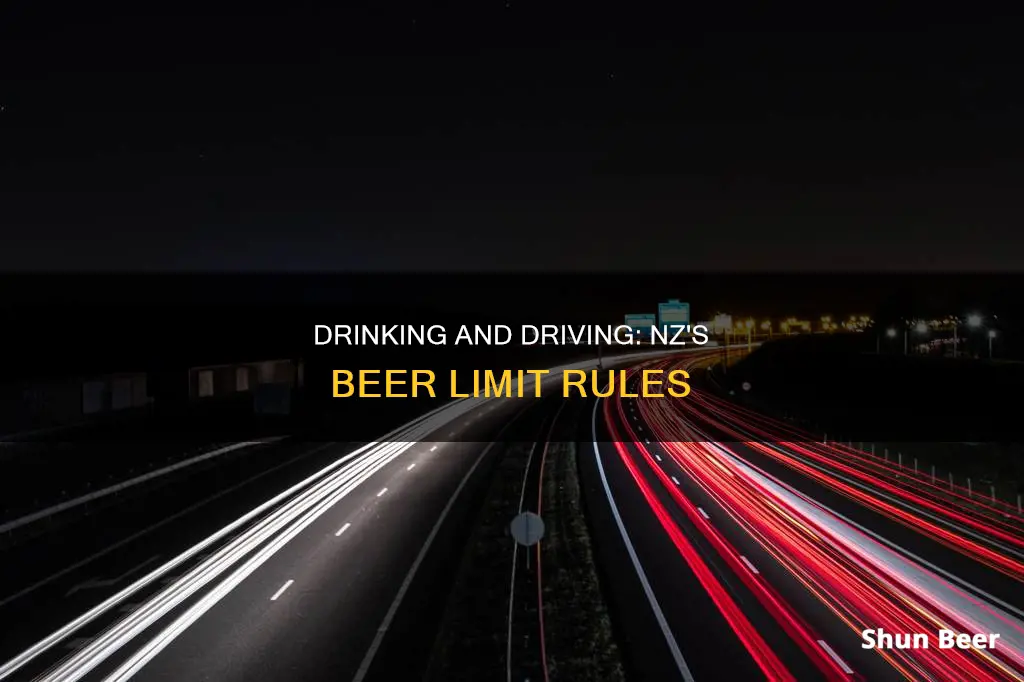
In New Zealand, the legal blood alcohol limit for drivers is 50 milligrams of alcohol per 100 millilitres of blood, or 250 micrograms of alcohol per litre of breath. For drivers under 20 years old, the limit is zero. While the number of beers a person can drink before reaching this limit will vary depending on factors such as body type, gender, weight, and food intake, even small amounts of alcohol can affect a person's judgement and ability to drive safely. Therefore, the best advice is to avoid driving if you are going to drink at all.
| Characteristics | Values |
|---|---|
| Legal alcohol limit for drivers under 20 years old | Zero |
| Legal alcohol limit for drivers 20 years and over | 250 mcg of alcohol per litre of breath |
| Legal alcohol limit for drivers 20 years and over | 50 mg of alcohol per 100 ml of blood |
| Amount of alcohol in a standard drink | 10 grams of pure alcohol |
| Number of standard drinks in a can of beer | 1.3 |
| Number of standard drinks in a glass of beer | 2 |
| Number of standard drinks in a bottle of beer | 4 |
| Number of standard drinks in 100ml of wine | 1 |
| Number of standard drinks in 32ml of straight spirits | 1 |
| Number of drinks that may keep you under the drink-driving limit | 2 standard drinks over 2 hours |
What You'll Learn

NZ's legal blood alcohol limit for drivers is 0.05% BAC for adults (20+)
In New Zealand, the legal blood alcohol limit for drivers is 50 milligrams (mg) of alcohol per 100 millilitres (ml) of blood, or a concentration of 0.05%. This limit applies to adults aged 20 and over. For drivers under the age of 20, the alcohol limit is zero.
It is important to note that alcohol is a significant cause of road accidents and fatalities in New Zealand. Even small amounts of alcohol can affect your judgement and driving ability. Therefore, it is always best to avoid drinking and driving altogether. If you plan to drink, make alternative travel arrangements, such as taking a taxi or bus, or arranging for a sober friend to drive you home.
To help you make informed choices about drinking and driving, it is useful to understand standard drink measurements. In New Zealand, a standard drink contains 10 grams of pure alcohol. This is typically equivalent to 330ml of beer, 100ml of wine, or 32ml of spirits, depending on the alcohol percentage. All alcohol containers in the country are required by law to display a label indicating the number of standard drinks they contain.
If you want to know your blood alcohol content before driving, you can use a personal breathalyser device. These devices can help you monitor your blood alcohol concentration (BAC) and ensure you do not exceed the legal limit. However, it is important to remember that there are many factors influencing how alcohol is absorbed into your system, including body type, gender, weight, and food intake.
Ginger Beer: A Standalone Beverage?
You may want to see also

Drivers under 20 have a zero alcohol limit
In New Zealand, drivers under 20 years of age are subject to a zero alcohol limit. This means that any driver under 20 must not consume any alcohol before getting behind the wheel. The legal drink-drive limit for this age group is a blood alcohol concentration (BAC) of zero. This is outlined in the Land Transport Act 1998, which sets the legal alcohol limits for drivers in New Zealand.
The zero alcohol limit for drivers under 20 is a critical road safety measure. Research has shown that even a small amount of alcohol can impair driving ability and slow reaction times. By enforcing a zero alcohol limit for young drivers, New Zealand aims to reduce the risk of alcohol-related accidents and keep its roads safer for everyone.
It is important to understand that the zero alcohol limit applies to any type of driving, whether it is a short trip or a long journey. Additionally, the limit applies regardless of the time of day or night. As a driver under 20, you must not drive if you have consumed any alcohol, even if you feel sober or believe that your driving ability is not impaired.
The consequences of drink-driving can be severe. If you are caught driving under the influence of alcohol, you may face penalties such as fines, demerit points, licence suspension, or even imprisonment. It is essential to abide by the zero alcohol limit to ensure your safety and the safety of other road users.
If you plan on drinking, it is best to arrange alternative transportation. This could include designating a sober driver, using public transport, or utilising ride-sharing services. By planning ahead, you can ensure that you and your friends stay safe and comply with New Zealand's drink-driving laws.
Beer Consultation: A Guide to the Process
You may want to see also

Alcohol is one of the leading causes of road crashes in NZ
In New Zealand, the alcohol limit for drivers aged 20 and over is 250 micrograms (mcg) of alcohol per litre of breath, and the blood alcohol limit is 50 milligrams (mg) per 100 millilitres (ml) of blood. For those under 20, the limit is zero—meaning that even one drink can result in a drink-driving charge. Despite this, alcohol is the second biggest contributing factor to road crashes in New Zealand.
Research shows that driving ability is impaired by alcohol consumption, even at low levels. Alcohol can slow reaction times and affect the senses and judgement, increasing the risk of a crash. At the current legal limit for drivers over 20, a person is twice as likely to have a crash as a driver with zero blood alcohol level. This limit may be exceeded after only a few drinks, depending on factors such as body type, rate of drinking, and the amount of food consumed.
The effects of alcohol on the body can greatly increase the risk of a crash. Once alcohol is absorbed into the bloodstream, it enters vital organs, including the brain, resulting in slowed reactions, dulled judgement and vision, and increased fatigue. These effects can impair a person's ability to drive safely and increase the likelihood of causing death or serious injury to themselves or others.
The consequences of drink-driving can be severe and far-reaching. In addition to the risk of causing harm to oneself or others, there are also legal and financial repercussions. These can include legal charges ranging from manslaughter to 'over the limit', penalties such as imprisonment, loss of licence, disqualification, and fines, and long-term financial costs. It is important to remember that even if a person believes they are below the legal alcohol limit, their driving ability may still be impaired, posing a risk to themselves and others.
Drinking Beer Upside Down: Does It Get You Drunker Faster?
You may want to see also

A standard drink in NZ contains 10 grams of pure alcohol
In New Zealand, the alcohol limit for drivers aged 20 and over is 250 micrograms of alcohol per litre of breath, and the blood alcohol limit is 50 milligrams per 100 millilitres of blood. If you are under 20, the alcohol limit for driving is zero.
The size of a standard drink depends on the strength of your beer, wine, or spirit. The higher the alcohol content, the smaller the size of a standard drink. For example, a 330ml bottle of 4% beer is a standard drink, but a 30ml measure of 37% bourbon is also a standard drink. Every can, bottle, or cask of alcohol must have a label that tells you how many standard drinks are inside. This number depends on the strength or percentage of the drink. You can also find out how many standard drinks are in a pack or bottle by looking for the standard drinks symbol on the label.
Understanding standard drinks is helpful because counting glasses on their own is not the easiest way to measure how much you've had to drink. One common serving of alcohol at a bar is often more than one standard drink, and looking at labels and counting standard drinks can help you monitor your consumption.
Drinking Beer Outside: Legal or Not?
You may want to see also

A breathalyser can help you monitor your blood alcohol level
In New Zealand, the legal alcohol limit for drivers aged 20 and over is 250 micrograms (mcg) of alcohol per litre of breath, and the blood alcohol limit is 50 milligrams (mg) per 100 millilitres (ml) of blood. For those under 20, the limit is zero.
Breathalysers work by calculating the concentration of alcohol in the breath to determine whether a person has consumed too much alcohol to drive safely. The alcohol vapour in a person's breath reacts with an orange solution called potassium dichromate, which turns green when alcohol is present. This colour change creates an electrical current, which the breathalyser can convert into a value to determine the BAC. The BAC limit in the US is generally 0.08%, but this varies from state to state.
It's important to note that drinking any amount of alcohol can impair your driving ability. The best thing to do is to not drive if you've been drinking at all. If you are going to drink, make sure you have a plan to get home safely, such as arranging a designated driver or planning to take a cab.
Morning Beer: Should You Drink Before Work?
You may want to see also
Frequently asked questions
The blood alcohol limit is 50 milligrams of alcohol per 100 millilitres of blood, or a concentration of 0.05%.
This depends on many factors, including the type of drink, your body type, gender, weight, and food intake. A standard drink in New Zealand contains 10 grams of pure alcohol, which is approximately equivalent to 330ml of beer, 100ml of wine, or 32ml of spirits. A good rule of thumb is that one standard drink will increase your Blood Alcohol Concentration (BAC) by 0.02%personal breathalyser to check your BAC. Alternatively, you can avoid drinking alcohol if you know you will be driving.
If you are caught driving with a BAC of 0.05% - 0.08%, you will be fined $200 and receive 50 demerit points. If your BAC is above 0.08%, you will be required to appear in court and may face imprisonment, a fine of up to $6000, and a loss of license.







